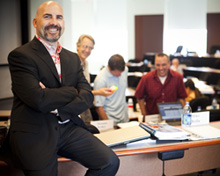People
July 19, 2010
Profile: Pop culture economist

Tom Smith
Tom Smith’s life is a mix of art and numbers, culture and analytics.
An associate professor of finance at Goizueta Business School, Smith first taught economics during his senior year at Illinois Wesleyan. He went on to earn post-graduate degrees at University of Illinois-Chicago.
His teaching method includes practical examples and illustrations in sports and entertainment. Smith’s dissertation focus was labor economics and the arts — areas he still follows as Goizueta’s “pop culture economist.” His recent research includes commentary on everything from reality shows to religion to salary caps in sports.
“I teach a lot of people in the MBA program with economics backgrounds,” he says. “I get tons of students who just had a terrible experience with economics. It’s not surprising for me to end up on a plane and, when the person next to me asks what I do, hear ‘Oh, economics... I hate economics.’”
Smith describes economics as an “incredibly important” subject he hopes to deliver in a way that makes sense to all audiences.
At a recent open house for prospective Evening MBA students, Smith explained advanced concepts of decision making and opportunity costs — the kind companies use when purchasing other brands — by showing challenges underclassmen face when leaving college for the NBA Draft. (A player can’t return to school the following season if he’s made the decision to go pro and sign with an agent.)
“Fascinated” by labor economics, Smith continues his research by attending human resources conferences and keeping an eye on an ever-changing work environment.
He also looks to loop in arts and entertainment. Away from work, he finds time to play bass, which he continues to do professionally when the opportunity arises.
It keeps him connected with his roots and inspires his teaching.
The son of an English professor and high school Spanish teacher, Smith went to college on a music scholarship. He majored in mathematics and earned extra money slapping bass with an 11-piece orchestra (jazz and a little bit of swing).
“Every weekend we’d get in this yellow van and drive all over Illinois, Indiana and Iowa. It was ridiculous,” Smith says. “That’s how I made money during school. We’d go to a Moose Lodge, or an Elks Lodge, or a Knights of Columbus hall or a dance hall in the middle of nowhere and play four sets from eight to midnight. We’d unload wearing a tuxedo then load up and drive back to the dorm.”
Back on campus, Smith hit the books but found scheduling conflicts threatened his dual love of music and math.
This led to a life-changing moment.
“It turned out Techniques of Proof and ensemble practice were always conflicting,” says Smith. On a whim, he took an economics class.
“I had an instructor that was vague, and I thought economics should be something that’s pretty clear. I looked at that as an opportunity to try my hand at something that made no sense,” he says, so “I jumped ship and I moved from math over to economics.”
Smith always wanted to teach in higher education. But it took a challenge — in scheduling and learning — to spark a passion to make tough subjects easier for future generations.
Economics, like a steady bass line from the band, provides some order to chaos. It’s a foundation.
Smith said he approaches his subject the same way.
“Economics explains behavior and how people and firms respond to incentives. It’s a foundation to examining how we act,” he says. “Everybody loves a good bass line. I try to do that for economics… one class at a time.”
